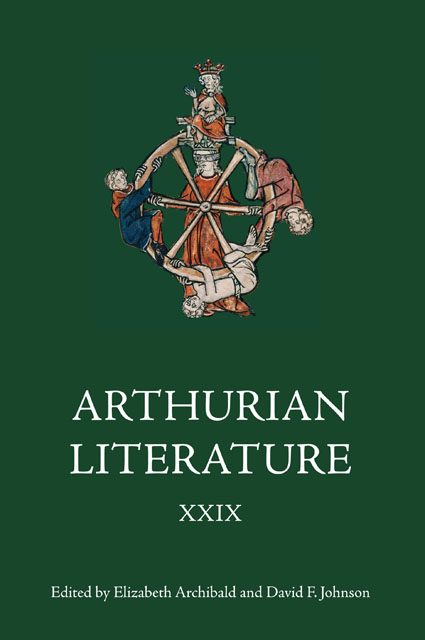Book contents
- Frontmatter
- Contents
- List of Illustrations
- General Editors’ Foreword
- List of Contributors
- I Edward III’s Abandoned Order of the Round Table
- II King Arthur’s Tomb at Glastonbury: The Relocation of 1368 in Context
- III Benedict of Gloucester’s Vita Sancti Dubricii: An Edition and Translation
- IV New Evidence for an Interest in Arthurian Literature in the Dutch Low Countries in the Fifteenth and Early Sixteenth Centuries
- V Malory’s Source-Manuscript for the First Tale of Le Morte Darthur
- VI Malory’s Sources – and Arthur’s Sisters – Revisited
- VII Peace, Justice and Retinue-Building in Malory’s ‘The Tale of Sir Gareth of Orkney’
- VIII Mapping Malory’s Morte: The (Physical) Place and (Narrative) Space of Cornwall
- IX The Fringes of Arthurian Fiction
- Contents of Previous Volumes
I - Edward III’s Abandoned Order of the Round Table
Published online by Cambridge University Press: 14 February 2023
- Frontmatter
- Contents
- List of Illustrations
- General Editors’ Foreword
- List of Contributors
- I Edward III’s Abandoned Order of the Round Table
- II King Arthur’s Tomb at Glastonbury: The Relocation of 1368 in Context
- III Benedict of Gloucester’s Vita Sancti Dubricii: An Edition and Translation
- IV New Evidence for an Interest in Arthurian Literature in the Dutch Low Countries in the Fifteenth and Early Sixteenth Centuries
- V Malory’s Source-Manuscript for the First Tale of Le Morte Darthur
- VI Malory’s Sources – and Arthur’s Sisters – Revisited
- VII Peace, Justice and Retinue-Building in Malory’s ‘The Tale of Sir Gareth of Orkney’
- VIII Mapping Malory’s Morte: The (Physical) Place and (Narrative) Space of Cornwall
- IX The Fringes of Arthurian Fiction
- Contents of Previous Volumes
Summary
On Thursday, 22 January 1344, rounding off in grand style a lavish tournament at Windsor Castle, King Edward III of England (r. 1327–1377) swore a ‘corporal oath’ (corporale juramentum) to restore the Order of the Round Table to the same ‘manner and standing’ as that of King Arthur, his legendary predecessor, provided he had the means. Receiving a consimile juramentum to ‘observe, sustain and promote’ the Round Table from the earls and accomplished knights in attendance, Edward III announced that the order’s first meeting would take place during Pentecost, and he commissioned the construction of a grand House of the Round Table at Windsor to serve as its centre. Not to be outdone, Philippe VI of France (r. 1328–1350), Edward’s arch-rival, reportedly began building a Round Table of his own, hoping to divert German and Italian knights from flocking to Edward’s court. Although most of the recorded outlay for the English house, £509 12s 11¾d, was spent in the days leading up to Pentecost (23 May) 1344, the order did not assemble as planned, possibly because its meeting place remained a work in progress. What may have been a temporary delay in May became an indefinite postponement by late November 1344, when papal arbitration at Avignon failed to resolve the latest conflict between the monarchs of England and France. Edward halted work on his costly project and prepared to launch a major continental campaign.
On St George’s Day (23 April) 1349, Edward III commemorated the victories of the aforementioned campaign, including that at Crécy (26 August 1346) and the capture of Calais (4 August 1347), by holding another great feast at Windsor Castle. This event did not mark the long-awaited re-establishment of the Round Table; rather, it inaugurated an entirely new chivalric order, the Order of the Garter, instituted under the patronage of St George and the Virgin Mary. Although near-contemporary writers regarded the Garter as the realization of his earlier endeavour, Edward neither resumed work on the House of the Round Table nor made any explicit reference to King Arthur in the statutes of his revamped order.
- Type
- Chapter
- Information
- Arthurian Literature XXIX , pp. 1 - 40Publisher: Boydell & BrewerPrint publication year: 2012

